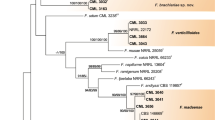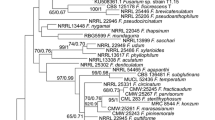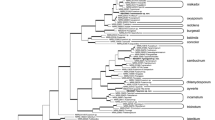Abstract
Fusarium isolates obtained as endophytes from healthy leaves of Handroanthus chrysotrichus (Bignoniaceae) in the Atlantic Forest of north-eastern Brazil were characterised morphologically and phylogenetically on the basis of partial rDNA sequences encompassing the second largest subunit of RNA polymerase II, translation elongation factor EF-1 alpha, and β-tubulin genes. A novel species within the Fusarium lateritium species complex (FLSC) is described as Fusarium massalimae. Isolates of F. pseudocircinatum of the Fusarium fujikuroi species complex (FFSC) were also isolated as endophytes from leaves of H. chrysotrichus. Mating type gene analyses suggested that obtained isolates of F. massalimae and F. pseudocircinatum are heterothallic.



Similar content being viewed by others
Data availability
The authors confirm that the data supporting the findings of this study are available within the article.
References
Afanide B, Mabadeje SA, Naqvi SHZ (1976) Gibberella baccata, the perfect state of Fusarium lateritium in Nigeria. Mycologia 68:1108–1111. https://doi.org/10.1080/00275514.1976.12019994
Al-Hatmi AM, Mirabolfathy M, Hagen F, Normand AC, Stielow JB, Karami-Osbo R, van Diepeningen AD, Meis JF, de Hoog GS (2016) DNA barcoding, MALDI-TOF and AFLP data support Fusarium ficicrescens as a distinct species within the F. fujikuroi species complex. Fungal Biol 120:265–278. https://doi.org/10.1016/j.funbio.2015.08.001
Aoki T, O’Donnell K, Geiser DM (2014) Systematics of key phytopathogenic Fusarium species: current status and future challenges. J Gen Plant Pathol 80:189–201. https://doi.org/10.1007/s10327-014-0509-3
Bacon CW, Hinton DM (1996) Symptomless endophytic colonization of maize by Fusarium moniliforme. Can J Bot 74:1195–1202. https://doi.org/10.1139/b96-144
Bezerra JDP, Santos MGS, Barbosa RN, Svedese VM, Lima DMM, MJS F, Gomes BS, Paiva LM, Almeida-Cortez JS, Souza-Motta CM (2013) Fungal endophytes from cactus Cereus jamacaru in Brazilian tropical dry forest: a first study. Symbiosis 60:53–63. https://doi.org/10.1007/s13199-013-0243-1
Bezerra JDP, Nascimento CCF, Barbosa RN, Silva DCV, Svedese VM, Silva-Nogueira EB, Gomes BS, Paiva LM, Souza-Motta CM (2015) Endophytic fungi from medicinal plant Bauhinia forficata: diversity and biotechnological potential. Braz J Microbiol 46:49–57. https://doi.org/10.1590/S1517-838246120130657
Bezerra JDP, Oliveira RJV, Paiva LM, Silva GA, Groenewald JZ, Crous PW, Souza-Motta CM (2017a) Bezerromycetales and Wiesneriomycetales ord. nov. (class Dothideomycetes), with two novel genera to accommodate endophytic fungi from Brazilian cactus. Mycol Prog 16:297–309. https://doi.org/10.1007/s11557-016-1254-0
Bezerra JDP, Sandoval-Denis M, Paiva LM, Silva GA, Groenewald JZ, Souza-Motta CM, Crous PW (2017b) New endophytic Toxicocladosporium species from cacti in Brazil, and description of Neocladosporium gen. nov. IMA Fungus 8:77–97. https://doi.org/10.5598/imafungus.2017.08.01.06
Demers JE, Gugino BK, Jiménez-Gasco MM (2015) Highly diverse endophytic and soil Fusarium oxysporum populations associated with field-grown tomato plants. Appl Environ Microbiol 81:81–90. https://doi.org/10.1128/AEM.02590-14
Edwards J, Auer D, de Alwis SK, Summerell B, Aoki T, Proctor R, Busman M, O’Donnell K (2016) Fusarium agapanthi sp. nov, a novel bikaverin and fusarubin-producing leaf and stem spot pathogen of Agapanthus praecox (African lily) from Australia and Italy. Mycologia 108:981–992. https://doi.org/10.3852/15-333
Fisher NL, Burguess LW, Toussoun TA, Nelson PE (1982) Carnation leaves as a substrate and for preserving cultures of Fusarium species. Phytopathology 72:151–153. https://doi.org/10.1094/Phyto-72-151
Garantonakis N, Pappas ML, Varikou K, Skiada V, Broufas G, Kavroulakis N (2018) Tomato inoculation with the endophytic strain Fusarium solani K results in reduced feeding damage by the zoophytophagous predator Nesidiocoris tenuis. Front Ecol Evol 6:126. https://doi.org/10.3389/fevo.2018.00126
Gargouri S, Balmas V, Burgess L, Paulitz T, Laraba I, Kim HS, Proctor RH, Busman M, Felker FC, Murray T, O’Donnell K (2020) An endophyte of Macrochloa tenacissima (esparto or needle grass) from Tunisia is a novel species in the Fusarium redolens species complex. Mycologia 112:1–16. https://doi.org/10.1080/00275514.2020.1767493
Garyali S, Kumar A, Sudhakara RM (2013) Taxol production by an endophytic fungus Fusarium redolens, isolated from Himalayan Yew. J Microbiol Biotechnol 23:1372–1380. https://doi.org/10.4014/jmb.1305.05070
Geiser DM, Lewis Ivey ML, Hakiza G, Juba JH, Miller SA (2005) Gibberella xylarioides (anamorph: Fusarium xylarioides), a causative agent of coffee wilt disease in Africa, is a previously unrecognised member of the G. fujikuroi species complex. Mycologia 97:191–201. https://doi.org/10.1080/15572536.2006.11832853
Gerlach W, Nirenberg HI (1982) The genus Fusarium — a pictorial atlas. Mitteilungen aus der Biologischen Bundesanstalt für Land- und Forstwirtschaft Berlin-Dahlem 209:1–406
Glass NL, Donaldson GC (1995) Development of primer sets designed for use with the PCR to amplify conserved genes from filamentous ascomycetes. Appl Environ Microbiol 61:1323–1330
Herron DA, Wingfield MJ, Wingfield BD, Rodas CA, Marincowitz S, Steenkamp ET (2015) Novel taxa in the Fusarium fujikuroi species complex from Pinus spp. Stud Mycol 80:131–150. https://doi.org/10.1016/j.simyco.2014.12.001
Imazaki I, Kadota I (2015) Molecular phylogeny and diversity of Fusarium endophytes isolated from tomato stems. FEMS Microbiol Ecol 91. https://doi.org/10.1093/femsec/fiv098
Joly CA, Aidar MPM, Klink CA (1999) Evolution of the Brazilian phytogeography classification systems: implications for biodiversity conservation. Cienc Cult 51:331–348
Katoh K, Standley DM (2013) MAFFT multiple sequence alignment software version 7: improvements in performance and usability. Mol Biol Evol 30:772–780. https://doi.org/10.1093/molbev/mst010
Kerényi Z, Moretti A, Waalwijk C, Ola’h B, Hornok L (2004) Mating type sequences in asexually reproducing Fusarium species. Appl Environ Microbiol 70:4419–4423. https://doi.org/10.1128/AEM.70.8.4419-4423.2004
Kumar S, Stecher G, Tamura K (2016) MEGA7: molecular evolutionary genetics analysis version 7.0 for bigger datasets. Mol Biol Evol 33:1870–1874. https://doi.org/10.1093/molbev/msw054
Kvas M, Marasas WFO, Wingfield BD, Wingfield MJ, Steenkamp ET (2009) Diversity and evolution of Fusarium species in the Gibberella fujikuroi complex. Fungal Divers 34:1–21. https://doi.org/10.1007/s13353-013-0146-0
Laurence MH, Walsh JL, Shuttleworth LA, Robinson DM, Johansen RM, Petrovic T, Vu TTH, Burgess LW, Summerell BA, Liew ECY (2016) Six novel species of Fusarium from natural ecosystems in Australia. Fungal Divers 77:349–366. https://doi.org/10.1007/s13225-015-0337-6
Lawrence EB, Nelson PE, Toussoun TA (1985) Inheritance of compatibility and sex in Gibberella baccata. Phytopathology 75:322–324. https://doi.org/10.1094/phyto-75-322
Leslie JF, Zeller KA, Logrieco A, Mule G, Moretti A, Ritieni A (2004) Species diversity of and toxin production by Gibberella fujikuroi species complex strains isolated from native prairie grasses in Kansas. Appl Environ Microbiol 70:2254–2262. https://doi.org/10.1128/AEM.70.4.2254-2262.2004
Liu YJ, Whelen S, Hall BD (1999) Phylogenetic relationships among ascomycetes: evidence from an RNA polymerase II subunit. Mol Biol Evol 16:1799–1808. https://doi.org/10.1093/oxfordjournals.molbev.a026092
Miller MA, Pfeiffer W, Schwartz T (2010) Creating the CIPRES Science Gateway for inference of large phylogenetic trees. In: Proceedings of the Gateway Computing Environments Workshop (GCE), 14 Nov, vol 2010. LA, New Orleans, pp 1–8
Moussa TAA, Al-Zahrani HS, Kadasa NMS, Ahmed SA, de Hoog GS, Al-Hatmi AMS (2017) Two new species of the Fusarium fujikuroi species complex isolated from the natural environment. Antonie Van Leeuwenhoek (6):819–832. https://doi.org/10.1007/s10482-017-0855-1
Myers N, Mittermeier RA, Mittermeier CG, da Fonseca GAB, Kent J (2000) Biodiversity hotspots for conservation priorities. Nature 403:853–845. https://doi.org/10.1038/35002501
Nirenberg HI (1976) Untersuchungen über die morphologische und biologische. Differenzierung in der Fusarium-Sektion Liseola Mitteilungen aus der Biologischen Bundesanstalt für Land- und Forstwirtschaft Berlin-Dahlem 169:1–117
Nirenberg HI, O’Donnell K (1998) New Fusarium species and combinations within the Gibberella fujikuroi species complex. Mycologia 90:434–458. https://doi.org/10.2307/3761403
Nylander JAA (2004) MrModeltest v2. Program distributed by the author. Uppsala University, Evolutionary Biology Centre
O’Donnell K, Kistler HC, Cigelnik E, Ploetz RC (1998) Multiple evolutionary origins of the fungus causing Panama disease of banana: concordant evidence from nuclear and mitochondrial gene genealogies. Proc Natl Acad Sci U S A 95:2044–2049. https://doi.org/10.1073/pnas.95.5.2044
O’Donnell K, Sutton DA, Rinaldi MG, Sarver BAJ, Balajee SA, Schroers HJ, Summerbell RC, Robert VARG, Crous PW, Zhang N, Aoki T, Jung K, Park J, Lee YH, Kang S, Park B, Geiser DM (2010) Internet-accessible DNA sequence database for identifying fusaria from human and animal infections. J Clin Microbiol 48:3708–3718. https://doi.org/10.1128/JCM.00989-10
O’Donnell K, Humber RA, Geiser DM, Kang S, Park B, Robert VARG, Crous PW, Johnston PR, Aoki T, Rooney AP, Rehner SA (2012) Phylogenetic diversity of insecticolous fusaria inferred from multilocus DNA sequence data and their molecular identification via FUSARIUM-ID and Fusarium MLST. Mycologia 104:427–445. https://doi.org/10.3852/11-179
O’Donnell K, Ward TJ, Robert VARG, Crous PW, Geiser DM, Kang S (2015) DNA sequence-based identification of Fusarium: current status and future directions. Phytoparasitica 43:583–595. https://doi.org/10.1007/s12600-015-0484-z
O’Donnell K, Sutton DA, Wiederhold N, Robert VARG, Crous PW, Geiser DM (2016) Veterinary fusarioses within the United States. J Clin Microbiol 54:2813–2819. https://doi.org/10.1128/JCM.01607-16
Oliveira Filho AT, Fontes MAL (2000) Patterns of floristic differentiation among Atlantic forests in Southeastern Brazil, and the influence of climate. Biotropica 32:793–810. https://doi.org/10.1111/j.1744-7429.2000.tb00619.x
Pappas ML, Liapoura M, Papantoniou D, Avramidou M, Kavroulakis N, Weinhold A, Broufas GD, Papadopoulou KK (2018) The beneficial endophytic fungus Fusarium solani strain K alters tomato responses against spider mites to the benefit of the plant. Front Plant Sci 9(1603). https://doi.org/10.3389/fpls.2018.01603
Postic J, Cosic J, Vrandecic K, Jurkovic D, Saleh AA, Leslie JF (2012) Diversity of Fusarium species isolated from weeds and plant debris in Croatia. J Phytopathol 160:76–81. https://doi.org/10.1111/j.1439-0434.2011.01863.x
Rayner RW (1970) A mycological colour chart. CMI and British Mycological Society, Kew
Rezende CL, Scarano FR, Assad ED, Joly CA, Metzger JP, Strassburg BBN, Tabarelli M, Fonseca GA, Mittermeier RA (2018) From hotspot to hopespot: an opportunity for the Brazilian Atlantic Forest. Perspect Ecol Conser 16:208–214. https://doi.org/10.1016/j.pecon.2018.10.002
Ronquist F, Huelsenbeck JP (2003) MRBAYES 3: Bayesian phylogenetic inference under mixed models. Bioinformatics 19:1572–1574. https://doi.org/10.1093/bioinformatics/btg180
Sandoval-Denis M, Guarnaccia V, Polizzi G, Crous PW (2018) Symptomatic Citrus trees reveal a new pathogenic lineage in Fusarium and two new Neocosmospora species. Persoonia 40:1–25. https://doi.org/10.3767/persoonia.2018.40.01
Santos ACS, Trindade JVC, Lima CS, Barbosa RN, Costa AF, Tiago PV, Oliveira NT (2019) Morphology, phylogeny and sexual stage of Fusarium caatingaense and Fusarium pernambucanum, new species of the Fusarium incarnatum-equiseti species complex associated with insects in Brazil. Mycologia 111:244–259. https://doi.org/10.1080/00275514.2019.1573047
Santos ACS, Diniz AG, Tiago PV, Oliveira NT (2020) Entomopathogenic Fusarium species: a review of their potential for the biological control of insects, implications and prospects. Fungal Biol Rev 34:41–57. https://doi.org/10.1016/j.fbr.2019.12.002
Short DP, O’Donnell K, Zhang N, Juba JH, Geiser DM (2011) Widespread occurrence of diverse human pathogenic types of the fungus Fusarium detected in plumbing drains. J Clin Microbiol 49:4264–4272. https://doi.org/10.1128/JCM.05468-11
Snyder WC, Hansen HN (1947) Advantages of natural media and environments in the culture of fungi. Phytopathology 37:420–421
Stamatakis A (2014) RAxML version 8: a tool for phylogenetic analysis and post-analysis of large phylogenies. Bioinformatics 30:1312–1313. https://doi.org/10.1093/bioinformatics/btu033
Summerell BA, Leslie JF (2011) Fifty years of Fusarium: how could nine species have ever been enough? Fungal Divers 50:135–144. https://doi.org/10.1007/s13225-011-0132-y
Sung GH, Sung JM, Hywel-Jones NL, Spatafora JW (2007) A multi-gene phylogeny of Clavicipitaceae (Ascomycota, Fungi): identification of localised incongruence using a combinational bootstrap approach. Mol Phylogenet Evol 44:1204–1223. https://doi.org/10.1016/j.ympev.2007.03.011
Tabarelli M, Pinto LP, Silva JMC, Hirota M, Bedê L (2005) Challenges and opportunities for biodiversity conservation in the Brazilian Atlantic Forest. Conserv Biol 19:695–700
Tima H, Brückner A, Mohácsi-Farkas C, Kiskó G (2016) Fusarium mycotoxins in cereals harvested from Hungarian fields. Food Addit Contam Part B Surveill 9:127–131. https://doi.org/10.1080/19393210.2016.1151948
Toghueo RMK (2019) Bioprospecting endophytic fungi from Fusarium genus as sources of bioactive metabolites. Mycology. https://doi.org/10.1080/21501203.2019.1645053
Van Diepeningen AD, Al-Hatmi AMS, Brankovics B, de Hoog GS (2014) Taxonomy and clinical spectra of Fusarium species: where do we stand in 2014? Curr Clin Micro Rpt 1:10–18. https://doi.org/10.1007/s40588-014-0003-x
Walsh JL, Laurence MH, Liew ECY, Sangalang AE, Burgess LW, Summerell BA, Petrovic T (2010) Fusarium: two endophytic novel species from tropical grasses of northern Australia. Fungal Divers 44:149–159. https://doi.org/10.1007/s13225-010-0035-3
White TJ, Bruns T, Lee S, Taylor L (1990) Amplification and direct sequencing of fungal RNA genes for phylogenetics. In: Innis MA, Gelfand DH, Sninsky JJ, White TJ (eds) PCR protocols. A guide to methods and applications. Academic Press, Cambridge, pp 315–322
Wollenweber HW (1917) Fusaria autographice delineata. Annales Mycologici 15:1–56
Yong YH, Dai CC, Gao FK, Yang QY, Zhao M (2009) Effects of endophytic fungi on growth and two kinds of terpenoids for Euphorbia pekinensis. Chin Trad Herb Drugs 40:18–22
Acknowledgements
Ana C. Silva Santos thanks the Conselho Nacional de Desenvolvimento Científico e Tecnológico (CNPq) − Brazil for a postdoctoral fellowship. Jadson D.P. Bezerra also thanks the Coordenação de Aperfeiçoamento de Pessoal de Nível Superior (CAPES, Finance Code 001) and the Fundação de Amparo a Ciência e Tecnologia de Pernambuco (FACEPE) for a postdoctoral fellowship (2017−2019). Anthony D. Cavalcanti thanks the Instituto Chico Mendes de Conservação da Biodiversidade (ICMBio) for the botanical material collection licenses. We would also like to thank the Project team, especially Andressa Vieira da Silva (MSc) for her help during plant collection, and to Dr. Hans-Josef Schroers and the three anonymous reviewers for their comments on earlier versions of this manuscript.
Code availability
Not applicable.
Funding
This study was financed in part by the project “Biologia da conservação de fungos sensu lato em áreas de Mata Atlântica do Nordeste brasileiro” approved by the CNPq and Instituto Chico Mendes de Conservação da Biodiversidade (ICMBio) – Finance Code 421241/2017-9. This research also received financial support from the project “Micoteca URM: caracterização e disponibilização do acervo como fonte de recursos microbiológicos”, approved by the FACEPE – Finance Code APQ-0143-2.12/15.
Author information
Authors and Affiliations
Corresponding authors
Ethics declarations
Conflict of interest
The authors declare that they have no conflict of interest.
Additional information
Section Editor: Hans-Josef Schroers
Publisher’s note
Springer Nature remains neutral with regard to jurisdictional claims in published maps and institutional affiliations.
Rights and permissions
About this article
Cite this article
Cavalcanti, A.D., da Silva Santos, A.C., de Oliveira Ferro, L. et al. Fusarium massalimae sp. nov. (F. lateritium species complex) occurs endophytically in leaves of Handroanthus chrysotrichus. Mycol Progress 19, 1133–1142 (2020). https://doi.org/10.1007/s11557-020-01622-3
Received:
Revised:
Accepted:
Published:
Issue Date:
DOI: https://doi.org/10.1007/s11557-020-01622-3




